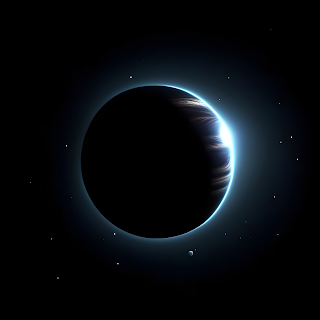 |
| TrES-2b |
The cosmos is a treasure trove of celestial marvels, offering us glimpses into the awe-inspiring diversity of otherworldly bodies beyond our solar system. In this journey, let's delve into the peculiarities of some enigmatic celestial objects that stand out for their distinctive features, bewildering atmospheres, and their extreme conditions that define them as otherworldly "hells."
In this blog article we talk about strangest and scariest planets:
1.PSR J1719 1438B
2.HD 188753AB
3.WASP-76B
4.GLIESE 1132B
5.TrES-2b
Hi! My name is Noel Gill. And let's start this article.
PSR J1719-1438b: The Diamond Planet
In the depths of space, PSR J1719-1438b emerges as an anomalous world orbiting a millisecond pulsar in the Serpens constellation. Its claim to fame lies in its composition, believed to be primarily made of carbon and oxygen, akin to a colossal cosmic diamond. The intense pressure on this exoplanet likely crystallizes carbon, forming an extraordinary gem-like structure, setting it apart from conventional planetary forms.
However, this alien jewel spins at an alarmingly close distance to its pulsar, completing orbits in just a couple of hours, presenting an environment too harsh for any conventional life as we know it.
HD 188753AB: A Triple Star System
Traveling further into the cosmos, we encounter the HD 188753 system, captivating with its triple star arrangement. This system includes a binary pair—HD 188753A and HD 188753B—and an orbiting third star, HD 188753Ab.
The intricacy of this system paints a mesmerizing cosmic dance, where two Sun-like stars dance in close tandem while a third star orbits from a greater distance. The orbits and interactions among these stars create a spectacle, yet the tumultuous gravitational forces and extreme stellar conditions pose challenges for the existence of life as we comprehend.
WASP-76b: Unveiling Extreme Atmospheres
In the exoplanet catalog, WASP-76b emerges as an extreme world orbiting a distant star in the constellation Pisces. This alien world's defining feature lies in its atmosphere, where peculiar conditions give rise to a phenomenon known as "hot rain."
The extreme proximity to its host star causes vaporization of certain elements on the scorching day side. As the planet rotates, the cooler night side might witness the condensation of these elements, creating an extraordinary meteorological event unlike any witnessed in our solar system.
Gliese 1132b: Between Hope and Hellish Realities
Amidst the stars, Gliese 1132b, nestled within the habitable zone, initially sparked hope for supporting life due to its location where liquid water might exist. However, subsequent studies suggest a different reality. The planet, though within this zone, might possess a thick and potentially Venus-like atmosphere, leading to extreme temperatures and inhospitable conditions.
The promise of habitability fades in the face of a hostile environment, with surface conditions potentially resembling a hellish landscape, thwarting any hopes of life as we recognize it.
TrES-2b: The Dark World
Venturing to the TrES-2b exoplanet, we encounter an enigmatic entity that stands out for its exceptionally dark nature. Reflecting less than 1% of the light that falls upon it, this peculiar world captivates researchers with its deep obscurity.
The reasons behind its profound darkness remain a scientific mystery, shrouded in possibilities of light-absorbing chemicals or substances within its atmosphere, marking it as a celestial anomaly amidst the cosmos.
Conclusion
As we explore these extraordinary celestial entities, we're reminded of the sheer diversity and peculiarity prevalent in the cosmos. Each of these celestial bodies, with their unique atmospheres, extreme conditions, and cosmic peculiarities, offers us glimpses into the boundless wonders of the universe. While some tantalize with the prospect of unearthly beauty, others present environments of extreme harshness, both contributing to our expanding knowledge of the cosmic tapestry.
In their strangeness, these celestial objects stand as testaments to the extraordinary nature of the cosmos and serve as beacons guiding our ongoing exploration into the mysteries that lie beyond our familiar skies.
Comments
Post a Comment